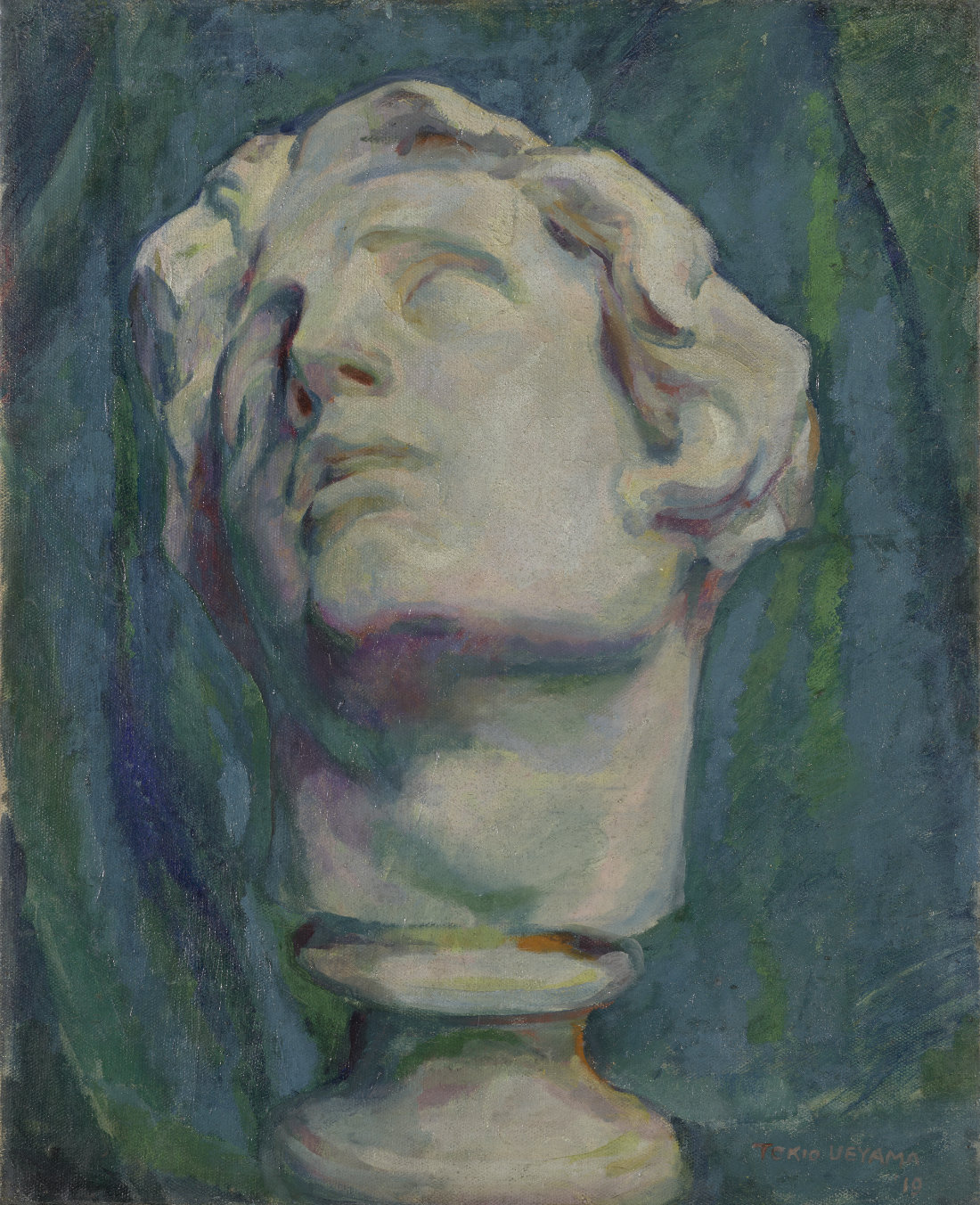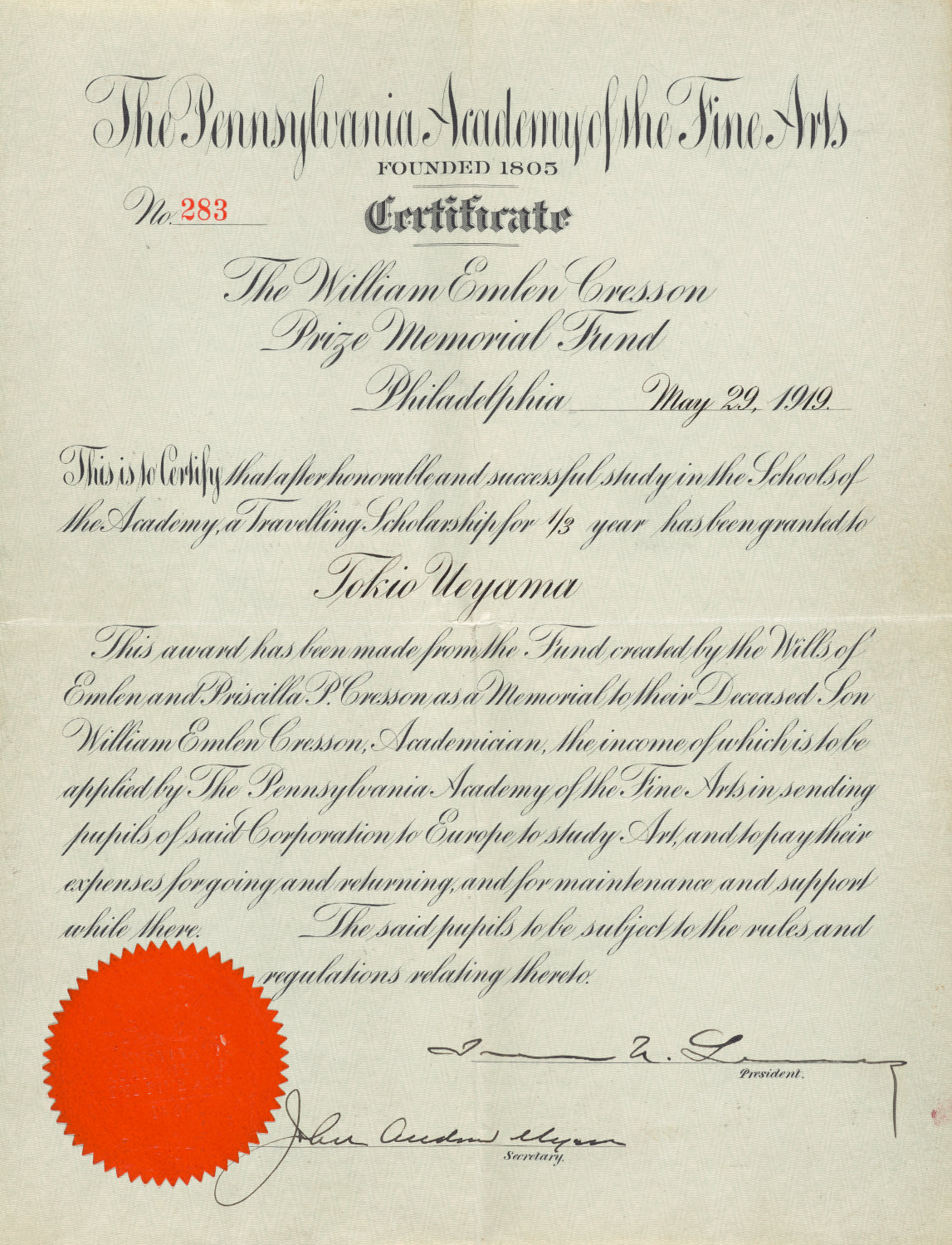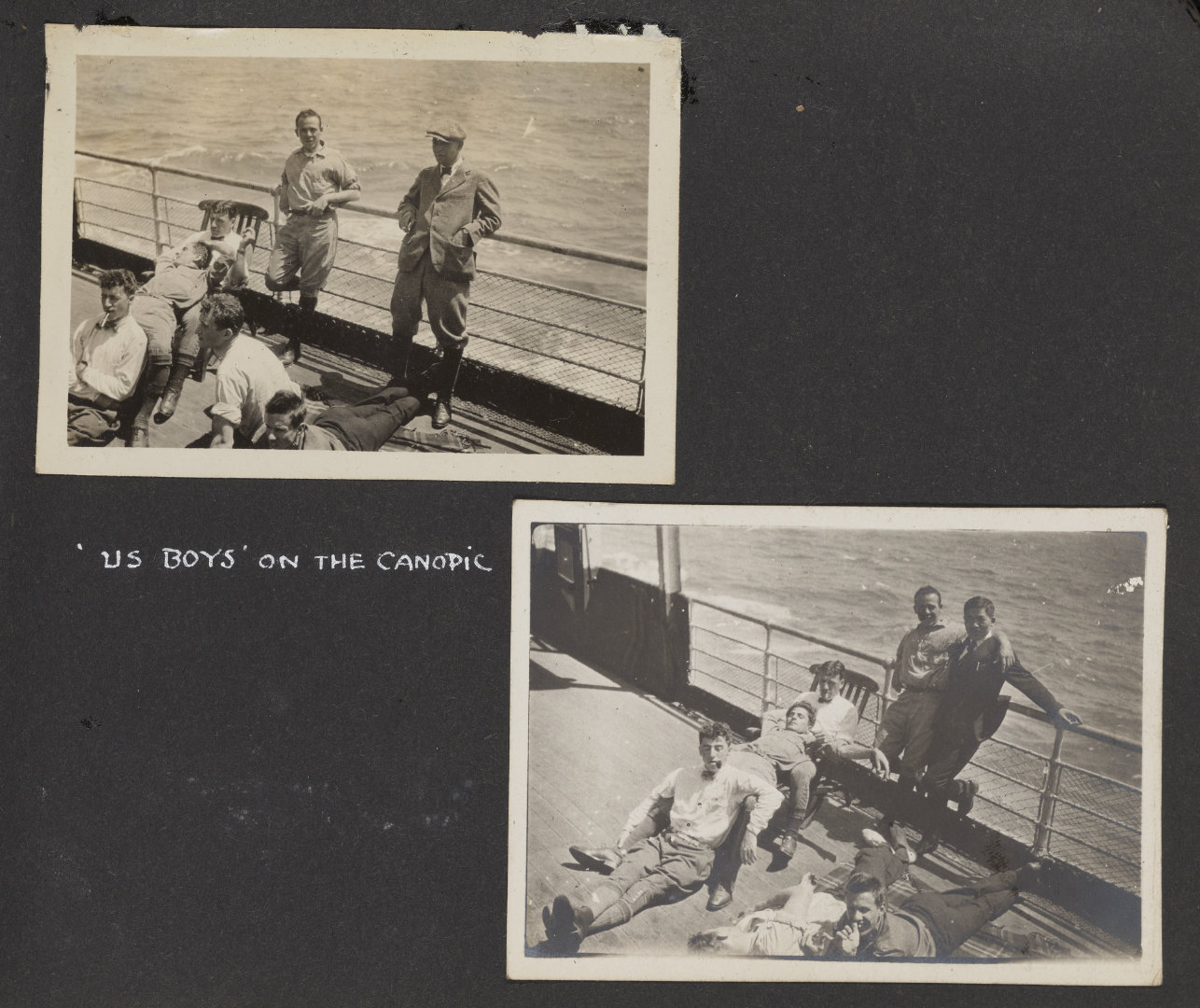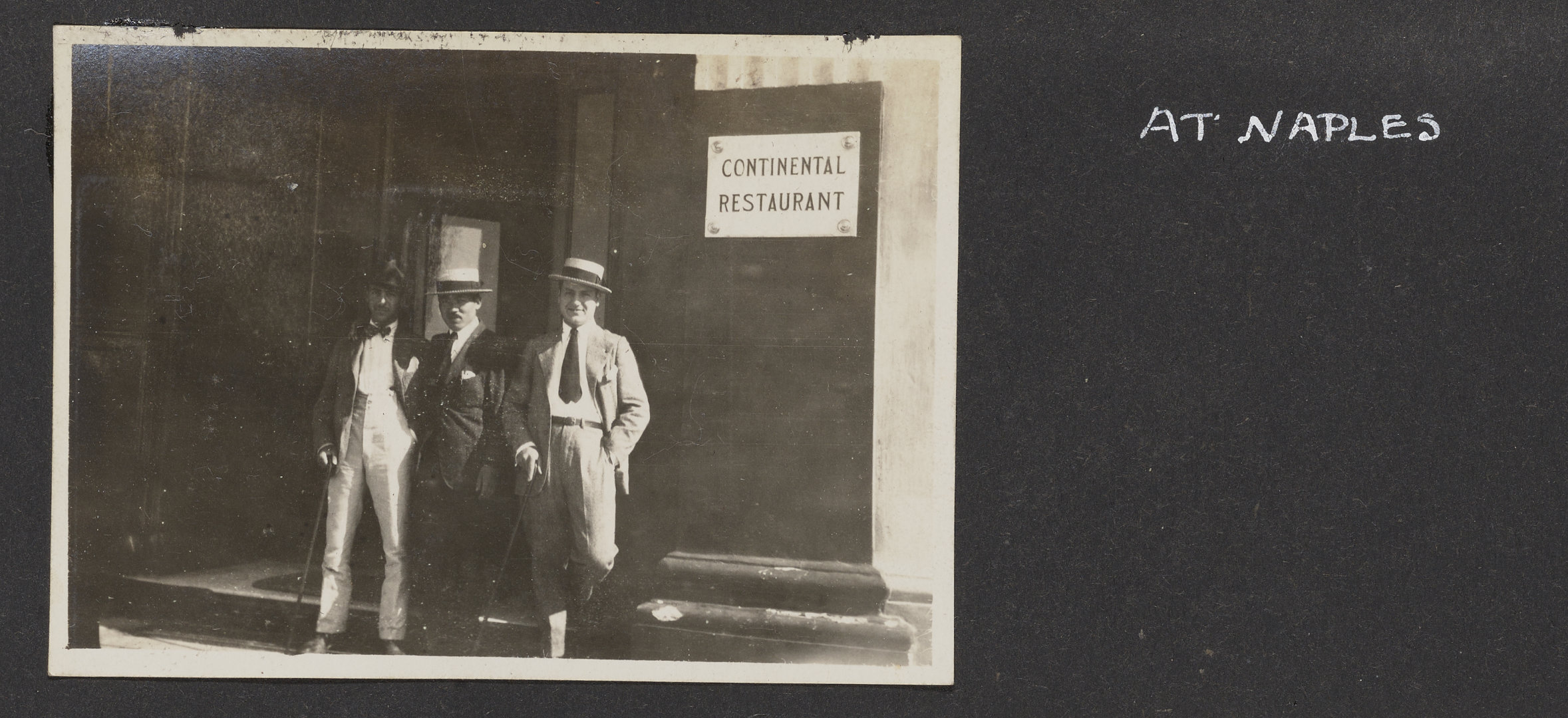Upon his arrival in the United States, Tokio Ueyama settled in San Francisco and enrolled at the California School of Design from November 1909 to February 1910.1 Very soon, however, he moved to Los Angeles and enrolled in the painters’ course at the University of Southern California, graduating with a degree in fine arts in 1914. Among a class of twelve students, ten women and two men, Ueyama was the only person of Japanese descent and the only person enrolled in the painters’ course.2 A large binder dated October 1916 filled with extensive typed notes, artists’ quotes, and highly detailed anatomical drawings suggests that he independently pursued his studies of historical artists and the human body.3
In 1917, Ueyama moved to Philadelphia to study at the
Pennsylvania Academy of the Fine Arts (PAFA).4
Established in 1805, PAFA was the first museum and school of
fine art in the country. By the turn of the twentieth century,
it maintained a prestige though was increasingly perceived as
conservative, in part because of its traditional teaching
styles rooted in representation of the human body.5
During the early 1920s, PAFA presented two significant
exhibitions incorporating modern aesthetics that helped to
change its stuffy reputation: the 1920
Paintings and Drawings by Representative Modern Artists, largely constituted of European impressionists,
post-impressionists, and avant-gardists, and the 1921
Paintings and Drawings by American Artists showing the
Later Tendencies in Art, which featured progressive styles by American artists.6
Given their prominence and the fact that they were displayed
while Ueyama was a student, it is highly likely he saw
them.7
As seen in his colorful painting of a
 sculpture bust, Ueyama combined traditional subjects with expressive color,
no doubt influenced by his academic studies and faculty and
the increasing prevalence of modern styles.8
sculpture bust, Ueyama combined traditional subjects with expressive color,
no doubt influenced by his academic studies and faculty and
the increasing prevalence of modern styles.8

In 1919, Ueyama won a
 William Emlen Cresson Memorial Travel Scholarship
to support three months of travel abroad.9
On July 8, 1920, he sailed on the ship Canopic to
Europe. He carefully documented his travels with photographs
and a written journal. It appears that he traveled with other
PAFA students—a group he refers to as “us boys” in a photograph taken on the Canopic (fig. 1)—and
occasionally met up with others throughout Europe.10
William Emlen Cresson Memorial Travel Scholarship
to support three months of travel abroad.9
On July 8, 1920, he sailed on the ship Canopic to
Europe. He carefully documented his travels with photographs
and a written journal. It appears that he traveled with other
PAFA students—a group he refers to as “us boys” in a photograph taken on the Canopic (fig. 1)—and
occasionally met up with others throughout Europe.10


The Canopic first stopped in the Azores, where Ueyama wrote that passengers took little boats to shore to visit “the most picturesque town I’ve ever seen . . . Houses are all very lightly tinted yellow, light blue, or pink with orange or vermillion roofs.”11 Color notes also show up in the album of his black-and-white photographs, such as next to an image of an Azores street scene (fig. 2). In his notebook, he mentions barefoot women with heads covered by shawls “like in the picture by Zuloaga.” Most likely, Ueyama had seen the work of the Spanish artist Ignacio Zuloaga (1870–1945) during an exhibition held at PAFA between April 7 and May 7, 1918.12 Such references and notes indicate that, while traveling, Ueyama thought through color and composition and called upon various facets of his art education to make sense of the new-to-him countries and cultures of Europe.

The Canopic carried on to Gibraltar, where Ueyama
stayed for multiple days and took a short excursion north into
Spain to witness the “horrible slaughter” of a bullfight. He
left the Canopic at Naples, where he stayed for more
than a week and took excursions to Capri and Pompei. In his
journal, he wrote brief impressions of landscapes, hotels,
restaurants, and people, most captured in short descriptive
notes. At the Hotel Continental in Naples, he wrote,
“Exquisite meal all European style. Waiters better dressed
than we . . . automatic elevator. Paved floor. Marble bathtub.
Balcony open to sea” (fig. 3). In Naples, he painted the
Castel dell’Ovo and later exhibited this watercolor as
 The Castle in Naples.13
Based on existing artworks and his journal, it seems that he
worked primarily in watercolor, and perhaps in prints, while
traveling.14
The Castle in Naples.13
Based on existing artworks and his journal, it seems that he
worked primarily in watercolor, and perhaps in prints, while
traveling.14


From Naples, Ueyama traveled by train to Rome, where he stayed for more than a week and took multiple art excursions with friends. From Rome, he took the train (on which “water is more expensive than wine”) to Florence before moving on to Venice, where it was raining and cold and a workers’ strike meant that most cafés and restaurants were closed. (And worse: “Even no ice cream.”) From Venice, he traveled to Milan for multiple days, noting its modernity and wide, clean streets, then on to Genoa, Nice, Marseille, and finally Paris. There, he seemed to have many American acquaintances. He noted wounded men with medals employed as guards and that paper was scarce—legacies of the First World War. He spent his birthday, September 22, in Paris before returning to the US via the SS France.
-
Founded in 1871, the school was formerly called the Mark Hopkins Institute of Art and later renamed the San Francisco Art Institute (SFAI). It closed in 2022, and its archives have been transferred to the SFAI Legacy Foundation + Archives. Ueyama’s instructors may have included Theodore Wores, John A. Stanton, M. Earl Cummings, Robert H. Fletcher, Harry Everett Alderson, C. Chapel Judson, and Alice B. Chittenden. See the 1909–10 California School of Design college catalog and Ueyama’s registration documents shared in an email to the author from Jeff Gunderson, Archivist/Librarian of the SFAI Legacy Foundation + Archives, June 20, 2023. ↩︎
-
In the 1915 yearbook that documents the Class of 1914, Ueyama’s associated quote is “Grows with all his growth and strengthens with all his strength.” See page 288 of the 1915 USC yearbook available through ancestry.com; and “University of Southern California Diploma,” Tokio Ueyama papers, 1908–circa 1954, bulk 1914–1945, Archives of American Art, Smithsonian Institution, https://www.aaa.si.edu/collections/tokio-ueyama-papers-22289/series-1/box-2-folder-8. Ueyama’s classmates included Helen A. Anderson (Teachers’ Course), Ruth W. Burns (Teachers’ Course), Jessie P. Calhoun (Special Teachers’ Course), Josephene Chambers (Design Class), Harvey Stewart Hastings (Illustrating Course), Edna A. Jones (Design Course), Jessie G. Layne (Teachers’ Course), Marion Leaver (Teachers’ Course), and Josephine L. Preble (Teachers’ Course). Unfortunately, a fire in the late 1910s destroyed many of the university’s early records, per an email to the author from Claude B. Zachary, University Archivist and Manuscripts Librarian, USC Libraries, June 12, 2023. A 1924 article states that Ueyama won a gold medal while at USC, though this is currently unverified. See “Exhibition of Japanese Artist’s Paintings Will Be Opened Today,” Oregon Daily Emerald, November 19, 1924, https://oregonnews.uoregon.edu/lccn/2004260239/1924-11-19/ed-1/seq-1/#words=Tokio+Ueyama. ↩︎
-
“Notebook, 1916,” Tokio Ueyama papers, Archives of American Art, https://www.aaa.si.edu/collections/tokio-ueyama-papers-22289/series-1/box-1-folder-13. ↩︎
-
According to his registration card, Ueyama enrolled on October 10, 1917, and listed his permanent address as 327 East First Street in Los Angeles. His Philadelphia addresses included 1608 Vine St., 1217 Green St., 241 [illegible ] 11th St., and 624 Locust St. Registration card provided in an email to the author from Hoang Tran, Director of Archives & Collections, PAFA, June 12, 2023. ↩︎
-
For example, students like Ueyama enrolled in the Department of Drawing and Painting would have attended the preparatory Antique Course, in which students drew from casts and still lifes and attended lectures on composition, perspective, and anatomy; the Life and Head Course, which included all advanced classes in drawing and painting, including from the human figure, the head, and still life, with lectures on composition and perspective; and a variety of Special Classes in composition, anatomy, perspective, and costume. Ueyama held onto his registration cards for the Life and Head course, dated January 26, 1918, May 31, 1919, January 31, 1920, January 29, 1921, and May 28, 1921. “Pennsylvania Academy of the Fine Arts Enrollment Cards, 1919–1924,” Tokio Ueyama papers, Archives of American Art, https://www.aaa.si.edu/collections/tokio-ueyama-papers-22289/series-1/box-1-folder-12. For information on departments, courses, and faculty, see the 1919–1920 School Circular (Philadelphia: Pennsylvania Academy of the Fine Arts, 1920). ↩︎
-
See Catalogue of an Exhibition of Paintings and Drawings by Representative Modern Artists (Philadelphia: Pennsylvania Academy of the Fine Arts, 1920), https://babel.hathitrust.org/cgi/pt?id=mdp.39015073813035&view=1up&seq=3; and Paintings and Drawings by American Artists showing the Later Tendencies in Art (Philadelphia: Pennsylvania Academy of the Fine Arts, 1921), https://library.si.edu/digital-library/book/paintingsdrawing00penn. Regarding this period of PAFA’s history, see Mark Hain, Stephen May, Kim Sajet, Ronald J. Onorato, Michael J. Lewis, and Peter M. Saylor, Pennsylvania Academy of the Fine Arts, 1805–2005: 200 Years of Excellence (Philadelphia: Pennsylvania Academy of the Fine Arts, 2005), 22–23. ↩︎
-
Thanks to PAFA’s online archives (https://pafaarchives.org/), information is readily available about the lectures, courses, scholarships, faculty, students, and exhibitions during the years Ueyama attended. ↩︎
-
A 1924 article states that at PAFA Ueyama studied with Henry McCarter, Hugh Breckenridge, and Daniel Garber. See “Exhibition of Japanese Artist’s Paintings Will Be Opened Today.” ↩︎
-
A different scholarship, the Cresson European Scholarship, sponsored one or more years of study abroad. These scholarships are often confused. See PAFA’s “William Emlen Cresson Memorial Travel Scholarship,” accessed May 14, 2024, https://pafaarchives.org/s/digital/page/cresson. Ueyama and the other sixteen winners of 1919 had to defer travel to Europe until after World War I had ended. See page 15 of the 1919–1920 PAFA School Circular. ↩︎
-
Cresson scholarship awardees can be searched by name or year at “William Emlen Cresson Memorial Travel Scholarship,” https://pafaarchives.org/s/digital/page/cresson. ↩︎
-
Large black notebook, Collection of Bunkado, Inc. All quotes from his European journey come from this source. ↩︎
-
Christian Brinton, Exhibition of Paintings by Ignacio Zuloaga under the Auspices of Mrs. Philip M. Lydid (1916), https://babel.hathitrust.org/cgi/pt?id=uc1.b3240967&view=1up&seq=7. ↩︎
-
See 1924 Sumida store exhibition catalog, no. 13, red scrapbook, 11, Collection of Bunkado, Inc.; Margaret Skavlan’s reference to it in the November 1924 exhibition in Eugene, Oregon: “Japanese Paintings Are Hung in University Art Gallery,” Oregon Daily Emerald, November 13, 1924, https://oregonnews.uoregon.edu/lccn/2004260239/1924-11-13/ed-1/seq-1/#words=Tokio+Ueyama; and clipping in red scrapbook, 9, Collection of Bunkado, Inc. ↩︎
-
In his journal, he notes while in Naples that he “sent unnecessary articles—paint box, shoes, books—back.” Perhaps his watercolor supplies were more convenient to travel with than oils. Additionally, in Rome he notes that he is “getting prints every day,” and the beginning of his travel journal includes notes on making ground for etching. ↩︎